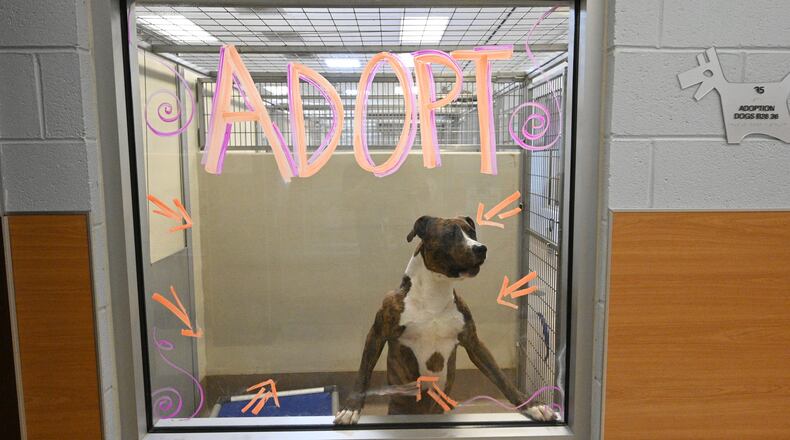In January, DeKalb County’s overwhelmed animal shelter issued a dire warning: Adopt a dog or we’ll have to kill some of them. As many as 150 canine lives were at stake.
Actually, they used the clinical term “euthanize.” But the public knew what they meant and there was a heartening rush of people who came to adopt and foster.
I visited the shelter after TV ran a story about its plight and found the halls packed with folks looking to make a difference, one mutt at a time.
Two weeks later, 292 dogs were left in the shelter that had housed almost 600. (Its capacity is 450, but it was built to handle about half of that.)
Metro area dog lovers exhaled. Whew!
And then the shelter steadily filled up again — 413 dogs in March, 538 in April, 571 in May and 619 in June, according to state inspections.
Credit: Bill Torpy
Credit: Bill Torpy
In August, a shelter volunteer contacted the state complaining there were 700 dogs there, many “living in filthy tiny prisons that quickly degrade them.”
State inspectors found 648 dogs, including numerous canines “unable to fully stand” in cramped cages. My colleague Sara Gregory recently wrote a story noting that the facility was cited for sanitation, housekeeping and overcrowding violations, as it had been several times during the previous year. (Inspectors also often noted that the understaffed facility crews were trying hard to rectify the problems.)
Now, the shelter is again asking the public to step up or, once again, they’ll be forced to euthanize. In fact, the so-called “no kill” shelter has been forced to do more of that.
“The last few months, we’ve had to euthanize some that we could have saved,” said Rebecca Guinn, CEO of LifeLine Animal Project, which has operated the shelters in DeKalb and Fulton counties since 2013.
The “no kill” moniker is not really correct. It’s more like a try-everything-else-before-killing-them policy. If a shelter euthanizes fewer than 90% of animals coming through, it receives the designation.
Credit: TNS
Credit: TNS
In August, the DeKalb Animal Services Advisory Board noted the “save rate is 86%. It dropped in July due to an increase of euthanasia as a result of space issues.” It’s now probably lower than that.
That board also noted that July’s “intake is up to 863 animals, the highest since 2019.” It did not designate between cats and dogs but it was certainly overwhelmingly the latter.
And of those dogs, the huge majority is some variety of pit bull mix. Last time I did an inventory of dogs listed on the website available for adoption, about 80% fit that bill.
It’s a conundrum that affects urban shelters everywhere. The dogs are wildly popular because there are so many — in and out of shelters — but the breed causes many people to pause when it comes to adopting them. The large majority come from south of Interstate 20.
Guinn noted the stigma that follows pit mixes and refers to them as “dogs with an athletic build.” Andrea Seidl, a shelter volunteer who is active with the recently reborn Advocates for DeKalb Animals, calls them “blocky headed dogs.”
It reminds me of people calling rambunctious kids “spirited.” (I must point out that the best dog we ever had was a pit from the pound.)
Shelters got a huge reprieve with COVID and lonely folks staying at home needing faithful, loving companionship. Now that they’ve returned to work, there’s less time for their pets. Or the economy is making it tough. Or apartments have limits on the size of a dog.
Guinn said many people are having to make agonizing decisions that include getting rid of their beloved pet.
Seidl points out that most dogs at the shelter are in the 1-to-5-year-old range. “The dog is no longer a puppy and now real demands occur,” she said.
Yes, responsibility is a pain.
The shelter’s website has an “Urgent!” classification under “Adopt.” The dogs listed there are next to be euthanized. Five were listed late Tuesday, two less than were there that morning.
Another sticking point for the shelter are dogs being held as “live evidence” for active court cases. A county review said there were 159 animals (again, mostly dogs) being held. Normally, a dog remains in the pound for 37 days. But dogs held for court stay an average of 329 days, clogging the shelter.
Sonali Saindane, who chairs the county’s animal advisory board, recounted the sad saga of Johnny, a pit mix born in the shelter in February 2021 and who remained there as “live evidence” as the case ground through the courts.
“He was a good puppy,” Saindane said. However, the stress of living locked up and surrounded by incessantly barking neighbors stressed him out. Ultimately, he bit a worker, delegating him as a bite risk and, ultimately, a euthanasia candidate.
Last month, he left the shelter. In a bag.
To help stem this long-term problem, the county plans to spend $7.5 million to expand the shelter — that is, if voters next month approve a sales tax initiative.
The county commission has also authorized $2.5 million, most of which is to build an emergency overflow capacity at the shelter.
But in the immediate future, there’s a dog waiting for you in DeKalb.
About the Author
Keep Reading
The Latest
Featured





